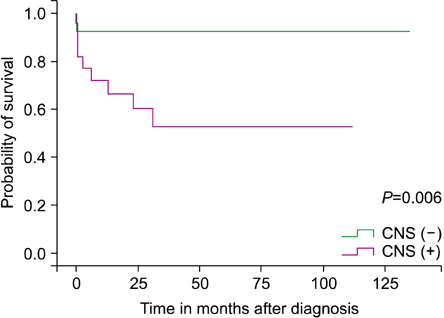Korean J Hematol.
2012 Dec;47(4):273-280. 10.5045/kjh.2012.47.4.273.
Central nervous system (CNS) involvement is a critical prognostic factor for hemophagocytic lymphohistiocytosis
- Affiliations
-
- 1Department of Pediatrics, Asan Medical Center, University of Ulsan College of Medicine, Seoul, Korea. tsko@amc.seoul.kr
- KMID: 1832106
- DOI: http://doi.org/10.5045/kjh.2012.47.4.273
Abstract
- BACKGROUND
Hemophagocytic lymphohistiocytosis (HLH) is a rare multisystem disorder that frequently involves the central nervous system (CNS). We compared the clinical characteristics, treatment, and prognosis of patients with HLH according to the degree of CNS involvement.
METHODS
The clinical manifestations, initial laboratory data, treatment, and outcomes for 50 patients diagnosed with HLH and treated at Asan Medical Center between January 1995 and August 2011 were retrospectively reviewed and analyzed. CNS involvement was defined as the presence of neurological symptoms or an elevated white blood cell (WBC) count in the cerebrospinal fluid (CSF).
RESULTS
Among these 50 patients, 23 (46%) developed CNS disease. Among patients with CNS disease, 19 had neurological symptoms, including seizures, altered consciousness, facial palsy, dysarthria, and dysphagia. Four patients had elevated CSF WBC counts without neurological symptoms. Twelve patients had abnormal brain imaging results, including high signal intensity lesions on T2-weighted magnetic resonance imaging (MRI) findings, ventriculomegaly, hemorrhage, atrophy, and leptomeningeal enhancement. Patients with CNS disease had lower ferritin, aspartate aminotransferase (AST), and alanine aminotransferase (ALT) levels as well as reduced 5-year survival as compared to those without CNS disease.
CONCLUSION
CNS involvement is common among patients with HLH. Overall, patients with CNS disease achieve poorer outcomes than patients without CNS involvement. To improve outcomes, physicians must carefully monitor the neurological manifestations in patients with HLH and administer the appropriate course of intensified chemotherapy to patients with CNS disease.
Keyword
MeSH Terms
-
Alanine Transaminase
Aspartate Aminotransferases
Atrophy
Central Nervous System
Central Nervous System Diseases
Consciousness
Deglutition Disorders
Dysarthria
Facial Paralysis
Ferritins
Hemorrhage
Humans
Leukocytes
Lymphohistiocytosis, Hemophagocytic
Magnetic Resonance Imaging
Neuroimaging
Neurologic Manifestations
Organothiophosphorus Compounds
Prognosis
Retrospective Studies
Seizures
Alanine Transaminase
Aspartate Aminotransferases
Ferritins
Organothiophosphorus Compounds
Figure
Reference
-
1. Henter JI, Elinder G, Söder O, Ost A. Incidence in Sweden and clinical features of familial hemophagocytic lymphohistiocytosis. Acta Paediatr Scand. 1991. 80:428–435.
Article2. Henter JI, Samuelsson-Horne A, Aricò M, et al. Treatment of hemophagocytic lymphohistiocytosis with HLH-94 immunochemotherapy and bone marrow transplantation. Blood. 2002. 100:2367–2373.
Article3. Thompson PA, Allen CE, Horton T, Jones JY, Vinks AA, McClain KL. Severe neurologic side effects in patients being treated for hemophagocytic lymphohistiocytosis. Pediatr Blood Cancer. 2009. 52:621–625.
Article4. Haddad E, Sulis ML, Jabado N, Blanche S, Fischer A, Tardieu M. Frequency and severity of central nervous system lesions in hemophagocytic lymphohistiocytosis. Blood. 1997. 89:794–800.
Article5. Henter JI, Nennesmo I. Neuropathologic findings and neurologic symptoms in twenty-three children with hemophagocytic lymphohistiocytosis. J Pediatr. 1997. 130:358–365.
Article6. Goo HW, Weon YC. A spectrum of neuroradiological findings in children with haemophagocytic lymphohistiocytosis. Pediatr Radiol. 2007. 37:1110–1117.
Article7. Horne A, Trottestam H, Aricò M, et al. Frequency and spectrum of central nervous system involvement in 193 children with haemophagocytic lymphohistiocytosis. Br J Haematol. 2008. 140:327–335.
Article8. Ouachée-Chardin M, Elie C, de Saint Basile G, et al. Hematopoietic stem cell transplantation in hemophagocytic lymphohistiocytosis: a single-center report of 48 patients. Pediatrics. 2006. 117:e743–e750.9. Janka G, Imashuku S, Elinder G, Schneider M, Henter JI. Infection- and malignancy-associated hemophagocytic syndromes. Secondary hemophagocytic lymphohistiocytosis. Hematol Oncol Clin North Am. 1998. 12:435–444.10. Henter JI, Aricò M, Egeler RM, et al. HLH study Group of the Histiocyte Society. HLH-94: a treatment protocol for hemophagocytic lymphohistiocytosis. Med Pediatr Oncol. 1997. 28:342–347.
Article11. Henter JI, Horne A, Aricó M, et al. HLH-2004: Diagnostic and therapeutic guidelines for hemophagocytic lymphohistiocytosis. Pediatr Blood Cancer. 2007. 48:124–131.
Article12. Stéphan JL, Donadieu J, Ledeist F, Blanche S, Griscelli C, Fischer A. Treatment of familial hemophagocytic lymphohistiocytosis with antithymocyte globulins, steroids, and cyclosporin A. Blood. 1993. 82:2319–2323.
Article13. Trottestam H, Horne A, Aricò M, et al. Chemoimmunotherapy for hemophagocytic lymphohistiocytosis: long-term results of the HLH-94 treatment protocol. Blood. 2011. 118:4577–4584.
Article14. Janka GE. Familial hemophagocytic lymphohistiocytosis. Eur J Pediatr. 1983. 140:221–230.
Article15. Aricò M, Janka G, Fischer A, et al. FHL Study Group of the Histiocyte Society. Hemophagocytic lymphohistiocytosis. Report of 122 children from the International Registry. Leukemia. 1996. 10:197–203.16. Hirst WJ, Layton DM, Singh S, et al. Haemophagocytic lymphohistiocytosis: experience at two U.K. centres. Br J Haematol. 1994. 88:731–739.
Article17. Henter JI, Elinder G. Familial hemophagocytic lymphohistiocytosis. Clinical review based on the findings in seven children. Acta Paediatr Scand. 1991. 80:269–277.
Article18. Imashuku S, Hyakuna N, Funabiki T, et al. Low natural killer activity and central nervous system disease as a high-risk prognostic indicator in young patients with hemophagocytic lymphohistiocytosis. Cancer. 2002. 94:3023–3031.
Article19. Kollias SS, Ball WS Jr, Tzika AA, Harris RE. Familial erythrophagocytic lymphohistiocytosis: neuroradiologic evaluation with pathologic correlation. Radiology. 1994. 192:743–754.
Article20. Fitzgerald NE, MacClain KL. Imaging characteristics of hemophagocytic lymphohistiocytosis. Pediatr Radiol. 2003. 33:392–401.
Article21. Lin TF, Ferlic-Stark LL, Allen CE, Kozinetz CA, McClain KL. Rate of decline of ferritin in patients with hemophagocytic lymphohistiocytosis as a prognostic variable for mortality. Pediatr Blood Cancer. 2011. 56:154–155.
Article22. Kim HK, Kim HG, Cho SJ, et al. Clinical characteristics of hemophagocytic lymphohistiocytosis related to Kawasaki disease. Pediatr Hematol Oncol. 2011. 28:230–236.
Article23. Takada H, Ohga S, Mizuno Y, et al. Oversecretion of IL-18 in haemophagocytic lymphohistiocytosis: a novel marker of disease activity. Br J Haematol. 1999. 106:182–189.
Article24. Janka GE. Familial and acquired hemophagocytic lymphohistiocytosis. Annu Rev Med. 2012. 63:233–246.
Article
- Full Text Links
- Actions
-
Cited
- CITED
-
- Close
- Share
- Similar articles
-
- CNS Involvement in Hemophagocytic Lymphohistiocytosis: CT and MR Findings
- Unrelated stem cell transplantation after reduced-intensity conditioning plus rituximab for Epstein-Barr virus-associated hemophagocytic lymphohistiocytosis with CNS involvement
- Serial Brain MRI Findings in CNS Involvement of Familial Erythrophagocytic Lymphohistiocytosis: A Case Report
- Severe Fever with Thrombocytopenia Syndrome Presenting with Hemophagocytic Lymphohistiocytosis
- Posterior reversible encephalopathy syndrome in pediatric patients undergoing treatment for hemophagocytic lymphohistiocytosis: clinical outcomes and putative risk factors



